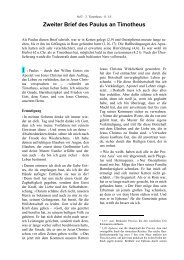You also want an ePaper? Increase the reach of your titles
YUMPU automatically turns print PDFs into web optimized ePapers that Google loves.
water here will soon be death’s prize. I wasn’t to<br />
know that at this very moment, only about 100<br />
metres from the stricken vessel, the torpedo boat<br />
Löwe was already taking the first of the survivors<br />
on board.<br />
“Many sets of eyes are now staring at the sinking<br />
colossus as she readies herself for dying; now the<br />
very second of her death has arrived for the ship. A<br />
loud booming sound comes from the Gustloff, as<br />
the last bulkheads are broken. The ship is listing<br />
more and more, as the screaming of those still on<br />
board reaches a crescendo. As the wreck tilts even<br />
further, suddenly the unexpected happens. As if<br />
controlled by a ghostly hand, in an instant the<br />
entire ship’s lighting comes on – the vessel shines<br />
in full splendour, looking like a magnificent apparition.<br />
The Gustloff goes down with full festive lighting.<br />
As if illuminated by the glow of her carefree<br />
days of peacetime, reflected a thousand-fold in the<br />
foaming ocean, the sinking coffin tips towards the<br />
waves and plunges into a watery grave. Blinded by<br />
the light, clusters of writhing people, bunched like<br />
grapes, spill overboard from the twenty metre wide<br />
sundeck, a scream of despair on their lips before<br />
they hit the water.<br />
“What now - another ghostly happening? The<br />
ship’s siren starts operating, all by itself, heralding<br />
the end of the Gustloff. A long drawn-out howling<br />
sound fills the air, then becomes weaker and<br />
hoarser. Then the howling siren is choked off, the<br />
light extinguished. The ship is dead – it sinks<br />
finally into the surging waters. A massive mountain<br />
of water crashes over the Gustloff, extinguishing<br />
the very last death cry.”<br />
(Heinz Schön: Die Gustloff-Katastrophe, Motorbuch<br />
Verlag Stuttgart, 4. Auflage 1995 pp 332,<br />
335-336)<br />
Another never-to-be-forgotten tragedy of maritime<br />
voyaging, one which is probably the bestknown<br />
worldwide, occurred in the year 1912. It<br />
was the sinking of the . On her maiden voyage,<br />
she was already set on a course to her death.<br />
The trauma of this story has remained to this day.<br />
The Titanic was regarded as the most significant<br />
ship of 1912. Costing more than seven million<br />
dollars, she was the largest movable object ever<br />
made by human hands. She was a skyscraper<br />
among ships, an oceanic giant four street blocks<br />
long, and eleven stories high. The shipping company,<br />
White Star Line, was exceptionally proud of<br />
her, giving this luxury liner the label “unsinkable”.<br />
The bulkheads to her 16 compartments could be<br />
individually closed to make them watertight; even<br />
if two of these compartments filled with water,<br />
the Titanic would float on. This was one of the<br />
reasons why the usual safety requirements were<br />
only partially fulfilled. For instance, there were<br />
only enough lifeboats for every second person on<br />
board.<br />
On April 10, 1912 the Titanic left Southampton in<br />
the south of England on her maiden voyage,<br />
bound for New York. Among the more than 2,200<br />
people on board were some of the richest people<br />
on earth. Also some of the poorest, wanting to<br />
make a new life in America. Both the famous and<br />
the forgotten were on the passenger list. A suite<br />
for the journey cost 5,000 dollars. Not surprisingly,<br />
morale and atmosphere on board was excellent;<br />
after all, the ship was the world’s fastest and<br />
safest, catering for its passengers’ every possible<br />
need. No one imagined that any harm could befall<br />
her. Iceberg warnings, among them those from<br />
the German ship Amerika, were widely ignored,<br />
since the Titanic was supposed to be especially<br />
invulnerable to iceberg damage.<br />
On the night of April 14, the world’s first and only<br />
“unsinkable” ship was about 400 nautical miles<br />
east of Newfoundland. Not a single cloud<br />
obscured the glittering stars on this moonless,<br />
bitterly cold night. The unusually dead calm conditions<br />
made the surface of the Atlantic appear<br />
like a sheet of polished glass. At 11:40 p. m. on<br />
Sunday, April the 14th, 1912, as the Titanic knifed<br />
through the smooth black sea, her starboard<br />
(right) side scraped along a massive iceberg, protruding<br />
about 30 metres above the water. A horrendous,<br />
91 metre long gash opened up in the<br />
269 metre long hull.<br />
The Titanic was now a death ship, with no one yet<br />
aware of it. Most of the passengers were in their<br />
cabins. A few crew members still sat talking in the<br />
first class dining salon on D deck. As they spoke,<br />
121
















